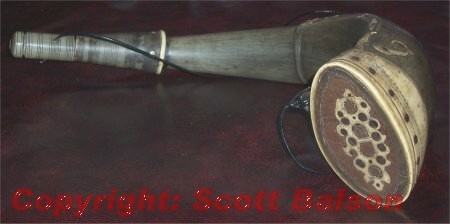
and several other authentic,
fascinating powder horns from around the world - all in the Balson Holdings Family Trust collection.

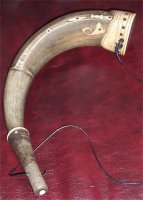 The
Griqua's love of hunting was second only to their love of talking the
talk.
The
Griqua's love of hunting was second only to their love of talking the
talk.
If you study their origins and their rise to power in central South Africa in the early 1800s you will understand how important powder, shot and the musket was to these extraordinary people.
The Griqua Buffalo Horn Powder Flask measuring 21 inches from top to toe and weighing nearly 1kg is owned by the Balson Holdings Family Trust is one of the jewels in the crown of this collection. This piece was carried by a Bergenaar (horse riding Griqua hunter) in the early 1800s when conquering the lands now known as the Orange Free State. The piece displayed to the right and in detail below was strung around his neck and carried on his back and side as he rode.
The piece has been professionally restored by a conservator, Amanda Pagliarino, at the Queensland Museum. Amanda said that the item is incredible condition for its age.
This extraordinary and priceless Griqua Buffalo Horn Powder Flask is carefully
inlaid with ivory held in place by small hardwood tacks originating from
that time. Two of the ivory inlays in the horn represent elephants while
the cap or top, made up of two pieces of ivory, has an ornate ivory engraving
which fits snugly to stop any gun powder falling out.. The cavity holding
the powder has been carefully carved out of the length of the horn. The base
of the horn has a small opening which is plugged by an ornately engraved
piece of ivory.
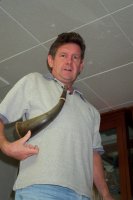
It was worn around the shoulder (see image right) as the Griqua Bergenaars galloped through the African bush after game or plundering the kraals of native tribes. The Buffalo Horn gives a snug and comfortable fit.
The image of Andries Africander carrying a powder horn like this one can be seen at this link.
This is a magnificent piece constructed, designed and used by the Griquas and, probably, because of its ornate design by Adam Kok himself.
It is an original and unique item who's origins can be found in the unique
Reminy's Collection established by Doctor William Guybon Atherstone
(seen right).
Provenance: An inventory note dated 5th June 1888 from from the Reminy's
Collection (see below) and held by the Balson Holdings Family Trust
describes this piece.
| In 2006 the powder horn was carefully renovated by
Amanda Pagliarino (more below) on behalf of the Balson Holdings Family
Trust
At an awards ceremony on 22 October 2005, Amanda Pagliarino (Conservator, Sculpture, QAG) was awarded the Australian Institute for the Conservation of Cultural Material (AICCM) Conservator of the Year 2005. This award recognises an outstanding contribution made by the recipient to the Australian conservation profession. Amanda is a graduate of the Bachelor of Applied Science (Conservation of Cultural Materials) degree at the University of Canberra. She was awarded the 2005 prize for her efforts in recent years to collect and disseminate information about modern materials and to provide professional development opportunities for the Australian conservation community, most particularly in the field of plastics conservation. Amanda's work is not just beneficial to sculpture conservators as modern materials are appearing more and more in collections — new polymers in paints and varnishes, plastic supports for traditionally paper-based items, audiovisual and digital media, and synthetic textiles. Plastics and other modern materials are also increasingly found in our museum buildings and used as storage materials. Amanda is currently the convenor of the AICCM Objects Special Interest Group, and has organised professional development programs for this group over the past three years. Most recently, she organised the 2005 AICCM Objects SIG Symposium, and a two-day course tutored by Thea van Oosten (Senior Researcher, Conservation Research Department, Netherlands Institute for Cultural Heritage), a world leader in the field of polymer conservation. Amanda recognised the need for further skills development in this area and has worked hard to bring about opportunities for specific skill development for Australian conservators. |
 |
Dr Atherstone, a renowned mineralogist and medical doctor based in
Grahamstown, played a major role in identifying South Africa's first
diamond, the Eureka Diamond, a
twenty carat stone found near Hopetown in the late 1860s. In his report to
Mr Boyes, who sent Atherstone the diamond, the doctor wrote:
"I congratulate you on the stone you have sent me.
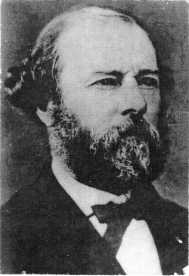 It
is a veritable diamond, weighs twenty-one and a quarter carats, and is worth
five hundred pounds. It has spoiled all the jewellers' files in Grahamstown,
and where that came from there must be lots more. Can I send it to Mr. Southey,
Colonial Secretary?"
It
is a veritable diamond, weighs twenty-one and a quarter carats, and is worth
five hundred pounds. It has spoiled all the jewellers' files in Grahamstown,
and where that came from there must be lots more. Can I send it to Mr. Southey,
Colonial Secretary?"
Atherstone was one of the most celebrated and well known medical men in South Africa. He had an international reputation not only in the field of medicine, but also in the other sciences. When only 21 years old, he was Staff Medical Officer in the Sixth Frontier War under Col. (later Sir) Harry Smith during which time he would have met the Griquas and taken possession of the powder horn now held in the Balson Holdings Family Trust collection.
It was during this trip to Bloemfontein that Sir Harry Smith said the immortal words to the Griqua's Kaptyn Adam Kok, "Southey tell them that I am the Governor General in South Africa. If they do not leave now I will hang their black Kaptyn from a beam in this ceiling."
During the time that Atherstone was practising in Grahamstown, he made medical history by successfully amputating the leg of Mr Fred Carlisle, Deputy Sherrif of Albany in 1847, by using the new anaesthetic diethyl ether. This was the first use of this method in any British Colony. Dr Atherstone was an extremely active man who, in addition to his medical profession and serving as the District Surgeon of Albany, had a wide range of subjects in which he was accomplished, such as music, art, astronomy, geology, botany and natural history. He had a wonderful collection of geological specimens, fossils and extensive notes. The huge saurian which he presented to the British Museum was named Tapio Cephalus Athersonii by Sir Richard Owen.
The Balson Holdings Family Trust owns an extremely rare three volume set of books entitled "Dr Atherstone - man of many facets" which was privately published by his family in Grahamstown.
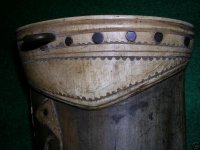 |
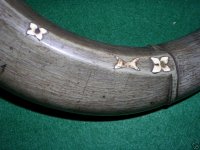 |
|
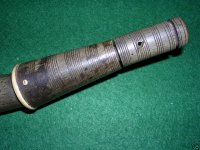 |
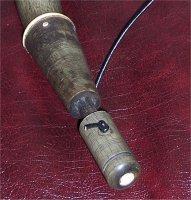 |
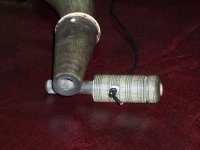 |
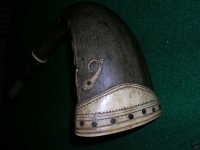 |
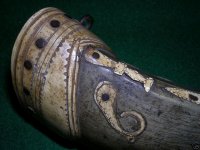 |
The use of natural products like animal horn and leather
in Africa for storing powder was quite common.
G & J.W. Hawksley Sheffield Brass & Copper Powder Flask (circa 1850)

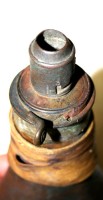
This powder flask was found on a farm in the
midlands KwaZulu Natal South Africa. This copper and brass powder flask has 4
drams : 3 , 2 3/4 , 2 1/2 and 2 1/4. There are 7,000 plump grains of wheat in
the King's pound. Each pound is divided in 16 ounces. Each ounce is divided into
16 drams. Thus, each dram is about 27.34 grain.
There is a
leather band still around the stem of the flask but the stitching has come
apart.
This powder flask was most probably used
during the time of the battle of the boers and the British for
Natal.
Antique Timor Powder Horn with Flint Case - Indonesia
Headhunter ”MEO” Era, kept as a sacred heirloom (c 1800)
A superb rare specimen with very fine engraving all over of motifs include fish, lizard, geometrics, swastika, sacred gecko
Old small crack to mouth of horn
Wood cap has mask head carved in
Size: 32.5cm Length
Weight: 241gm
From Rick Bennett collection - sold on eBay 7th July 2009
From Australia - 1800s
An original antique powder horn, it was used for storing gun powder for mussel loading rifles it also has its original powder measure. It is in lovely, original condition and measures 30cm in length.
The powder horn used by the pioneers in America .. also in the Balson Holdings Family Trust collection (below).
Mainly brass powder
horn (length 30cm) used by militant Islamic in the region around Morocco in north Africa c1800-1849
The elaborate moulding Other side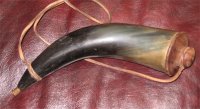
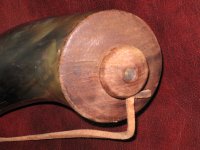
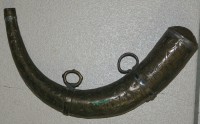
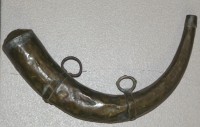
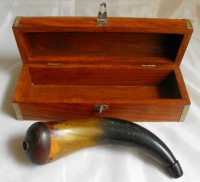
The Antique Old Colonial Musket Gun Powder Horn used by the pioneers in Australia
.. also in the Balson Holdings
Family Trust collection (below).
The previous owner had this beautiful wooden chest or container made for it, which has silver beading around it. The chest itself is made from stripes of red wood of some type which is very hard and heavy. Absolutely beautifully made and obviously made by an elite craftsman to hold a dearly beloved treasure. The old musket horn smells just like old gun powder. This is a delightful and very rare piece of old Australian History. It was aquired from Ballarat in the 1970's.
A more recent (1940) US powder horn (length 40cm) decorated with the art of "Montana Nick" on 25 November 1940...
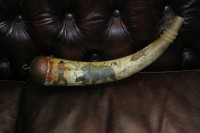 |
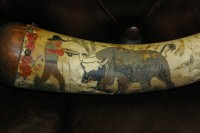 |
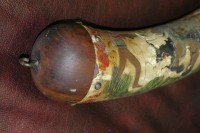 |
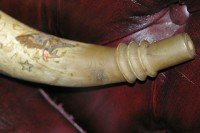 |
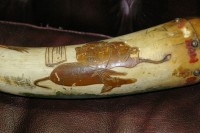 |
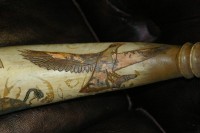
|
An old 1800s powder horn (origins and exact age unknown) - length
18cm
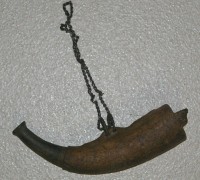
|
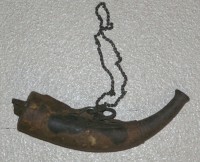
|
In Kenya the Maasai used a cow's horn
- as can be seen by this smaller six inch container (below) in the Balson Holdings Family Trust collection.Comparison of the size of the three fascinating powderhorn relics: